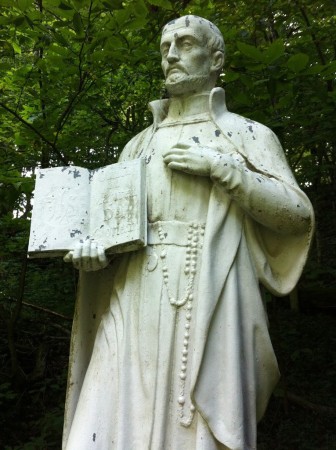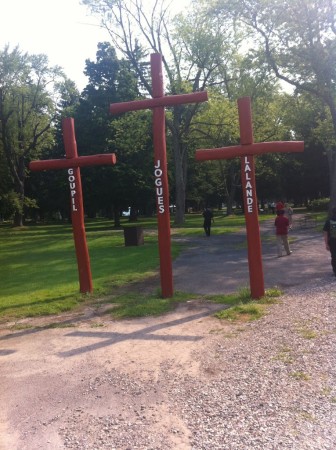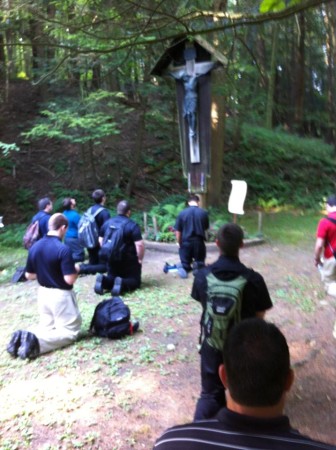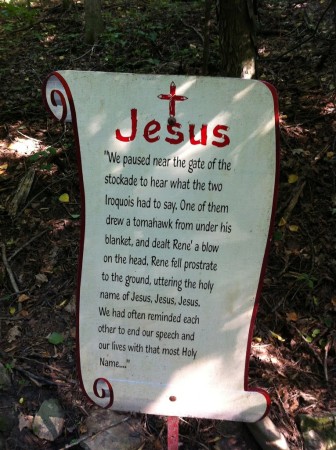 |
| St. Isaac Jogues statue, Shrine of the North American Martyrs |
Today is the optional memorial of the North American Martyrs: Sts. Isaac Jogues and John de Brebeuf, and their companions, a group of truly heroic Jesuit martyrs. St. Isaac Jogues was influential in my vocational discernment. I knew next to nothing about him prior to winter 2010, when he became my saint for the year for 2011. When I began seriously discerning later that year, Jogues kept popping up in unusual places. For example, my vocations director gave me Fr. Brett Brannen’s To Save a Thousand Souls to assist in my discernment (by the way, I highly recommend this book to any man contemplated diocesan priesthood). In the book, Fr. Brannen describes Jogues as a model of what a priestly heart looks like.
Given his priestly heart, it’s fitting that the Shrine of the North American Martyrs was one of the stops on the Archdiocesan seminarian pilgrimage this year. As a pilgrimage, it was spiritually fruitful for all of us. Here is how I described Jogues last year:
He was a Frenchman by birth, but joined the Jesuits to spread the Gospel and save souls. He was sent as a missionary to the Hurons, the tribe also known as Wyandots. This went well until the Hurons were attacked by the Mohawks, a tribe so notorious that their name means “man-eaters.”
The Mohawks believed the Jesuits, who they called the “blackrobes” (in reference to their cassocks), were sorcerers, both because of the sacraments, and because disease seemed to follow in their footsteps. They’d also learned enough about Catholicism to have some shocking cruel forms of torture. For example, they burnt off or ate several of Isaac’s fingers, to make it impossible for him to consecrate the Eucharist.
For thirteen months, he underwent constant torture at the hands of the Mohawk, without even attempting escape. It wasn’t until the Mohawks planned to burn him alive that Isaac allowed himself to be rescued by some Dutch Calvinists. He went back to Europe, where he received a special dispensation to consecrate the Eucharist with his remaining fingers. Said Pope Urban VIII: “It would be shameful that a martyr of Christ not be allowed to drink the blood of Christ.” And indeed, that’s what Isaac was: a living martyr. He voluntarily laid down his life for Christ, only to be allowed to take it up again (see John 10:18).
Then Isaac did the unthinkable. He laid down his life a second time for the same people, saying as he left his home country again, “I go, but I shall not return.” And indeed, he didn’t. Although he was at first well-received, after the Mohawks’ crops failed, they turned on him, torturing him with knives, tomahawking him to death, and beheading him.
Even in death, he lead others to Christ. He inspired his colleague, Father Jean de Brébeuf, to face his own martyrdom three years later, with bravery and confidence in the Lord,. And incredibly, Isaac Jogues’ killer even converted to Christ, taking the baptismal name Isaac Jogues.
We paused near the gate of the stockade to hear what the two Iroquois had to say. One of them drew a tomahawk from under his blanket, and Rene’ a blow on the head. Rene fell prostrate to the ground, uttering the holy name of Jesus, Jesus, Jesus.
We had often reminded each other to end our speech and our lives with that most Holy Name…
P.S. These martyrs sowed the seed that bore fruit in the next generation in the life of Kateri Tekakwitha, who will be formally declared a Saint this coming Sunday.



